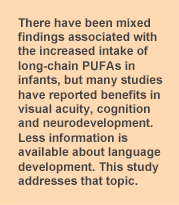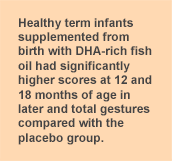
Many studies of infant development have reported improved visual, cognitive and neurodevelopmental scores in infants with higher consumption of long-chain polyunsaturated fatty acids (PUFAs). Improvements have been easier to demonstrate in preterm infants compared with term infants because of the nutrient shortages many preterm infants have. However, not all studies have observed improved development scores, so the value of providing higher levels of long-chain PUFAs through breast milk or infant formula has been controversial. Some reasons for the mixed findings are the inadequacy of the dose, sensitivity of the assessment tool, age when the evaluation is conducted and variations in infants themselves. Sometimes, a battery of tests is needed.

In an effort to overcome these difficulties, researchers in Australia designed a study of healthy term infants who were supplemented with high-dose, DHA-rich fish oil or a placebo from birth until 6 months of age. The amount of DHA provided was approximately 250 mg per day. The oil was given either in the infant’s formula or squirted directly into the infant’s mouth. The investigators focused on the child’s language and gestures to assess communication, but also included the Bayley Scales of Infant and Toddler Development, which have a language component, when the children were 18 months of age. At 6 months of age, the DHA-supplemented infants had higher levels of DHA in their blood and red blood cells, an expected finding. Evaluations at 12 and 18 months of age revealed some differences between the DHA and placebo groups. At both times, the DHA-supplemented children had higher scores for gesture communication compared with the placebo group. The supplemented children also had higher scores for phrases and words understood, but these were not significantly different from the placebo children because of the wide variation in scores in both groups. None of the language scores on the Bayley Scales differed between the groups. Using a different c

ommunications assessment, the MacArthur-Bates Communicative Development Inventory, the investigators observed significantly higher scores in the DHA-supplemented children for later and total gestures compared with the unsupplemented children at 12 and 18 months of age. The authors of the study suggested that higher gesture scores, that is more extensive use of gestures, might be linked to improved spoken language and communication, vocabulary and linguistic development, as evidence has suggested. There are only a few other studies that have examined language development in relation to omega-3 PUFA consumption in infants and children. Some have reported lower language scores with supplementation, but the differences disappeared with time. Others have found no effects of omega-3s.
 Many studies of infant development have reported improved visual, cognitive and neurodevelopmental scores in infants with higher consumption of long-chain polyunsaturated fatty acids (PUFAs). Improvements have been easier to demonstrate in preterm infants compared with term infants because of the nutrient shortages many preterm infants have. However, not all studies have observed improved development scores, so the value of providing higher levels of long-chain PUFAs through breast milk or infant formula has been controversial. Some reasons for the mixed findings are the inadequacy of the dose, sensitivity of the assessment tool, age when the evaluation is conducted and variations in infants themselves. Sometimes, a battery of tests is needed.
Many studies of infant development have reported improved visual, cognitive and neurodevelopmental scores in infants with higher consumption of long-chain polyunsaturated fatty acids (PUFAs). Improvements have been easier to demonstrate in preterm infants compared with term infants because of the nutrient shortages many preterm infants have. However, not all studies have observed improved development scores, so the value of providing higher levels of long-chain PUFAs through breast milk or infant formula has been controversial. Some reasons for the mixed findings are the inadequacy of the dose, sensitivity of the assessment tool, age when the evaluation is conducted and variations in infants themselves. Sometimes, a battery of tests is needed. In an effort to overcome these difficulties, researchers in Australia designed a study of healthy term infants who were supplemented with high-dose, DHA-rich fish oil or a placebo from birth until 6 months of age. The amount of DHA provided was approximately 250 mg per day. The oil was given either in the infant’s formula or squirted directly into the infant’s mouth. The investigators focused on the child’s language and gestures to assess communication, but also included the Bayley Scales of Infant and Toddler Development, which have a language component, when the children were 18 months of age. At 6 months of age, the DHA-supplemented infants had higher levels of DHA in their blood and red blood cells, an expected finding. Evaluations at 12 and 18 months of age revealed some differences between the DHA and placebo groups. At both times, the DHA-supplemented children had higher scores for gesture communication compared with the placebo group. The supplemented children also had higher scores for phrases and words understood, but these were not significantly different from the placebo children because of the wide variation in scores in both groups. None of the language scores on the Bayley Scales differed between the groups. Using a different c
In an effort to overcome these difficulties, researchers in Australia designed a study of healthy term infants who were supplemented with high-dose, DHA-rich fish oil or a placebo from birth until 6 months of age. The amount of DHA provided was approximately 250 mg per day. The oil was given either in the infant’s formula or squirted directly into the infant’s mouth. The investigators focused on the child’s language and gestures to assess communication, but also included the Bayley Scales of Infant and Toddler Development, which have a language component, when the children were 18 months of age. At 6 months of age, the DHA-supplemented infants had higher levels of DHA in their blood and red blood cells, an expected finding. Evaluations at 12 and 18 months of age revealed some differences between the DHA and placebo groups. At both times, the DHA-supplemented children had higher scores for gesture communication compared with the placebo group. The supplemented children also had higher scores for phrases and words understood, but these were not significantly different from the placebo children because of the wide variation in scores in both groups. None of the language scores on the Bayley Scales differed between the groups. Using a different c ommunications assessment, the MacArthur-Bates Communicative Development Inventory, the investigators observed significantly higher scores in the DHA-supplemented children for later and total gestures compared with the unsupplemented children at 12 and 18 months of age. The authors of the study suggested that higher gesture scores, that is more extensive use of gestures, might be linked to improved spoken language and communication, vocabulary and linguistic development, as evidence has suggested. There are only a few other studies that have examined language development in relation to omega-3 PUFA consumption in infants and children. Some have reported lower language scores with supplementation, but the differences disappeared with time. Others have found no effects of omega-3s.
ommunications assessment, the MacArthur-Bates Communicative Development Inventory, the investigators observed significantly higher scores in the DHA-supplemented children for later and total gestures compared with the unsupplemented children at 12 and 18 months of age. The authors of the study suggested that higher gesture scores, that is more extensive use of gestures, might be linked to improved spoken language and communication, vocabulary and linguistic development, as evidence has suggested. There are only a few other studies that have examined language development in relation to omega-3 PUFA consumption in infants and children. Some have reported lower language scores with supplementation, but the differences disappeared with time. Others have found no effects of omega-3s.

